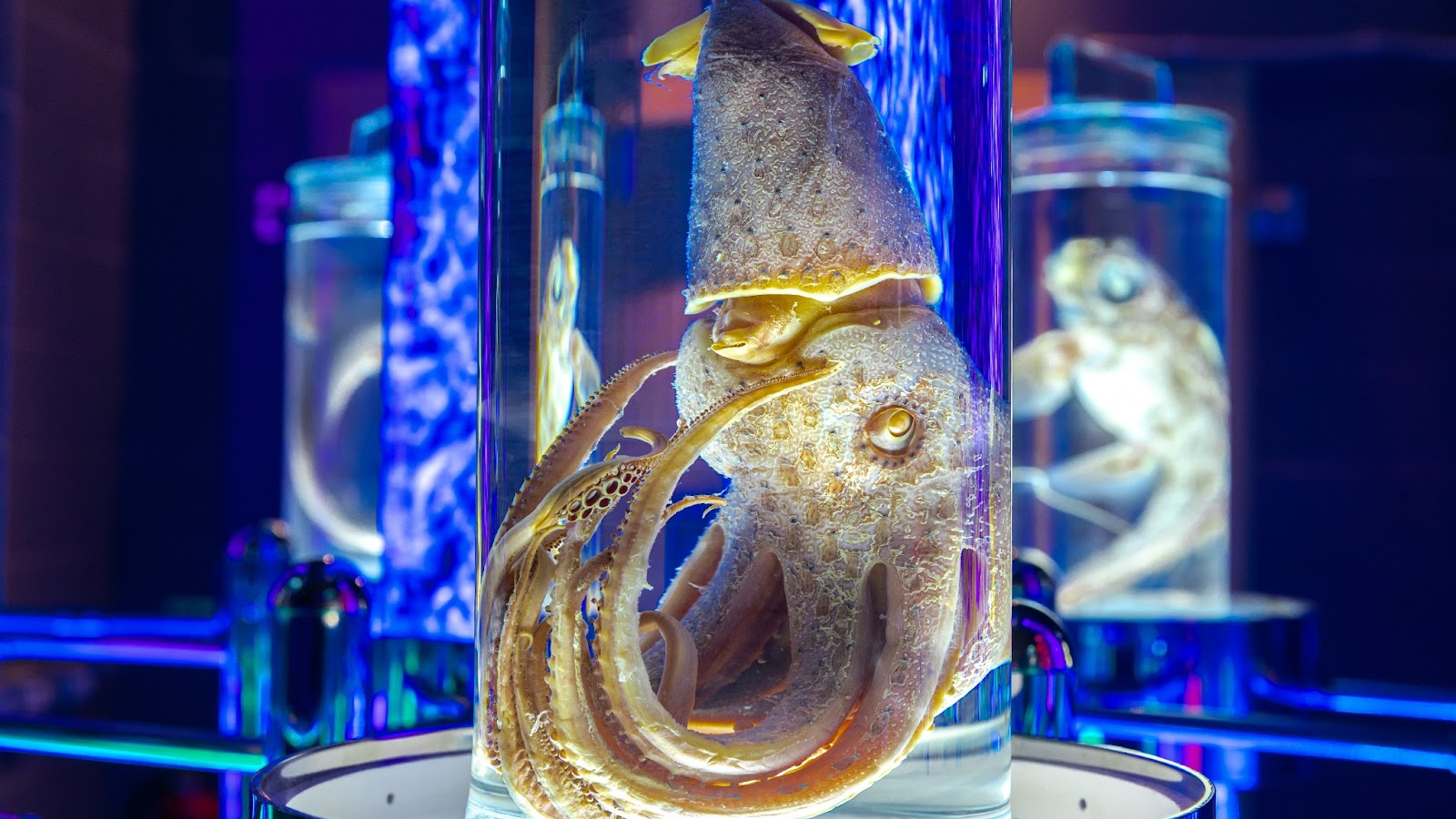For as long as sailors have navigated the oceans and for as extensively as researchers have studied the creatures that live among its greatest depths, a universal mystery remains: what else is out there?
The answer rests with the scientists who explore the ocean floors with new discoveries every year and engage the public so they can play an active role in protecting the world’s most precious ocean resources against real threats like climate change that are showing up beneath the microscope.
With approximately 90% of ocean species not yet named by science and the public’s insatiable quest to fill in the details of the unknown with legends, lore and mythology, it is easy to blur the lines between myth and reality.
While most people will never go inside an ocean research lab, there is a rare opportunity for the public to view some of the real creatures unearthed from the ocean floor that offers new insight into what is known and still unknown about the deep sea.
A public exhibition called the Monsters of the Deep, located at the Historic Dockyard in Chatham, England until November 2023, unmasks some of the mystery surrounding ocean monsters and how researchers are finding, collecting and studying some of the most fascinating creatures that exist.
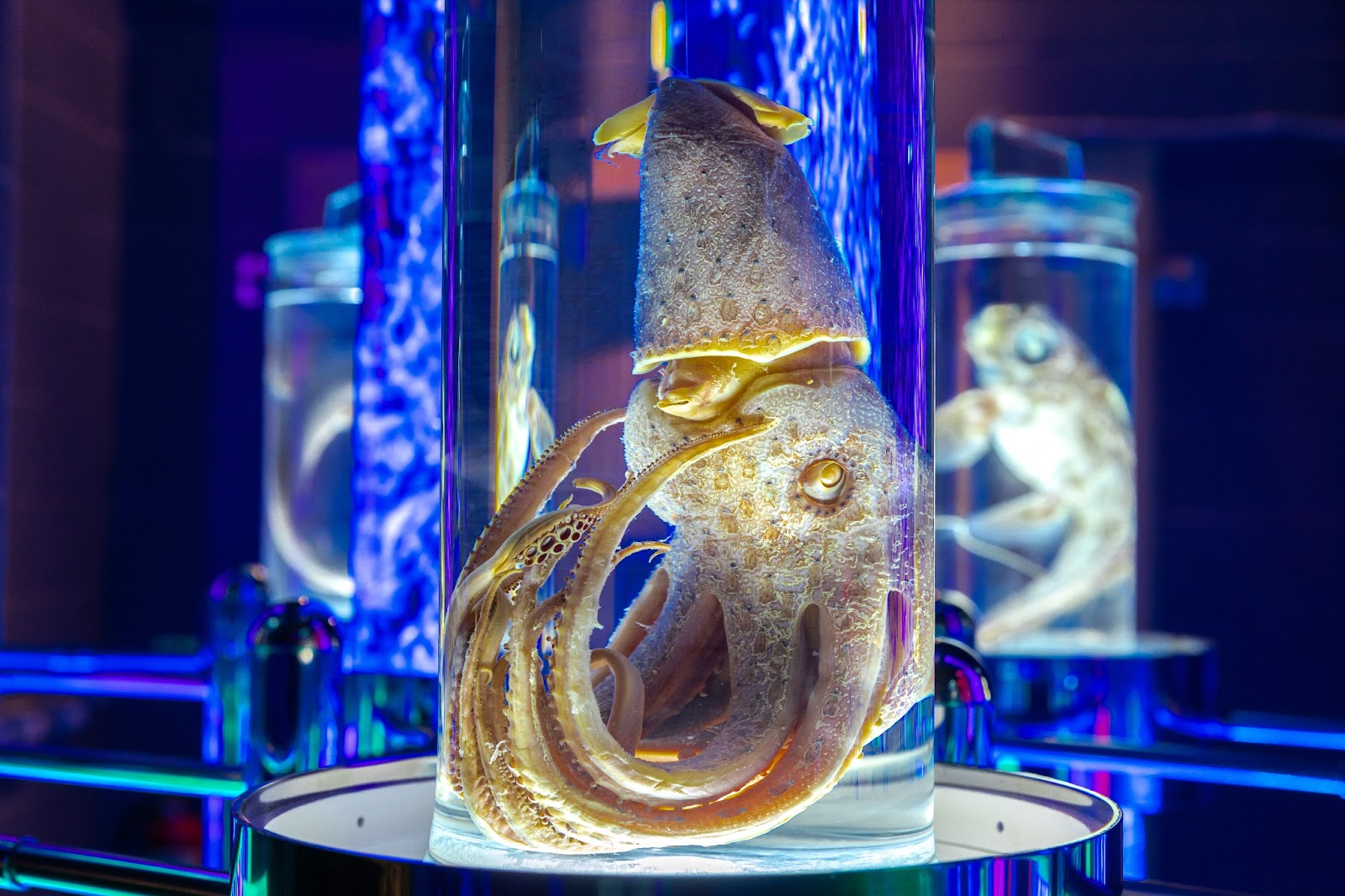
Specimen of a cock-eyed squid on display in England. Photo by Vikki Rimmer
Whether you fall on the side of science or science-fiction, few people can resist the allure of dramatic stories about deep-sea monsters, like the kraken that has been the subject of folklore, storylines, and movie plots since it was first noted in the 1700s. The colossal octopus is described as capable of bringing down ships and sinking them into the ocean depths. And then there’s the mermaid – still as mystical and captivating today as in her mythological origins. She’s been both celebrated and feared through time yet remains one of the most famous deep-sea creatures with both believers and non-believers. These are the kinds of legends that will remain immortalized in pop culture, movies and in imagination but scientists continue to uncover new and unusual species that rival the mystical ones.
From as far back as Medieval times, stories and folklore about sea monsters consume our imaginations, mystify oceanographers and feed into the curiosities about the bizarre and sometimes scary creatures that live at the bottom of the ocean.
Pulling back the curtain on these discoveries gives the public a rare chance to reconcile their own thoughts about what lives among the deep and their own role in helping to protect the organisms and marine life that rely on it for survival.
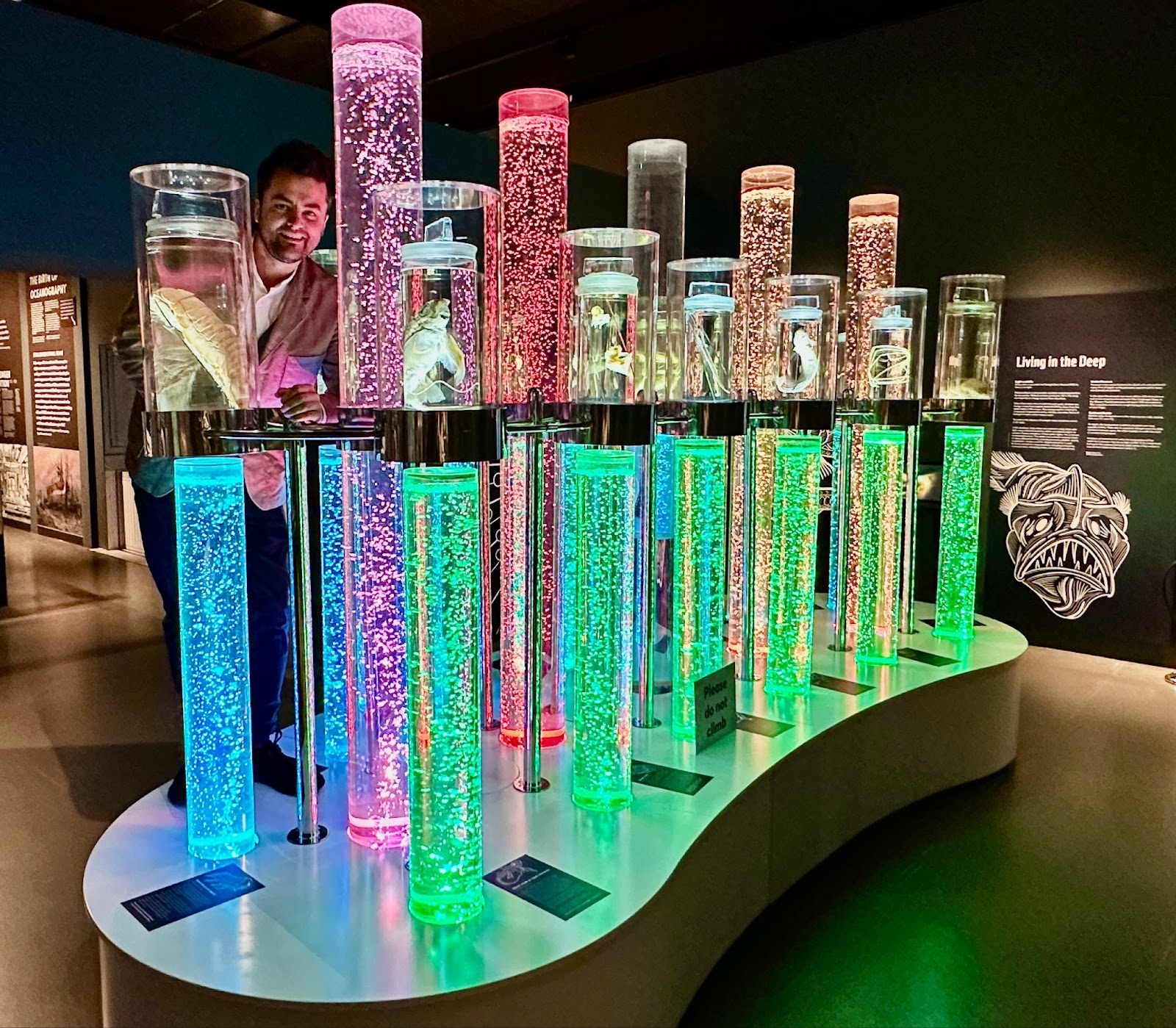
Monsters of the Deep Gallery Curator Nick Ball stands with the prized specimens of the exhibition in England. Photo by Anietra Hamper
Sea monsters revealed
Some of the most extensive research of the world’s ocean floors happens at the Discovery Collections laboratories located within the National Oceanography Centre in Southampton, England.
For only the second time since 1925 several specimens are on loan from the lab for public display in the Monsters of the Deep exhibition.
This unique exhibition is curated by the National Maritime Museum Cornwall showcasing some of the most feared, storied, and unusual specimens ever collected from the ocean depths. It combines a scientific education about ocean research from its origins through present day and parallels that information with the superstitions and folklore that made sea creatures popular long before science ever entered the equation.
“It’s an interactive exhibition showing scientific specimens and historical artifacts that look into the history of monsters and humanity's relationship with them,” said Nick Ball, collections, galleries and interpretation manager.
Monsters of the Deep combines mythology, science, paleontology, oceanography, cryptozoology, astronomy and more disciplines allowing visitors to see where science and myth intersect. But, to understand the oceanography research of today and the possibilities for future discoveries, it’s important to look at how it originated and the impact of science on previous knowledge that was only ever collected through the stories of seafarers.
The Monsters of the Deep exhibition begins with charts from the Medieval period showing mythological monsters identified only from the tales of sailors’ accounts of unusual sightings and creatures that washed up on shore. The journey starts there then divides visitors onto two tracks through a deep ocean exploration.
“You see one side that continues looking at the mythology surrounding it, looking at the Victorian period and circus shows with different creatures and wonders of the world, then the other side branches off into the science of the deep ocean, beginning with HMS Challenger,” said Ball.
The HMS Challenger was the first noted oceanography research expedition in 1872 that brought science into the mix of ocean knowledge and changed the course of research going forward. The HMS Challenger showcased the ability to retrieve specimens from underwater regions once thought to be inaccessible. The Royal Navy research vessel spent four years sailing around the globe collecting information and samples to investigate the depths, temperature, and living organisms in the ocean. Specimens and data were collected from the seabed of 362 locations spanning nearly 70,000 nautical miles and studied along the way in an onboard laboratory.
This expedition was pivotal for oceanography research. It changed the understanding of what scientists know about varying ocean conditions and the life that depends on it as well as opened the possibilities for collecting new data going forward. This expedition resulted in the discovery of an estimated 4700 new species. It also uncovered new data about the extensive depths of the Mariana Trench in the Pacific Ocean, the deepest trench known to exist on Earth.
The specimens on display to the public are on loan from a vast collection of partners including the Royal Museums Greenwich, Tyne and Wear Museums, British Library, Booth Museum, Cambridge University, Science Museum, University of Southampton, National Maritime Museum Cornwall, Whitstable Museum and Royal Engineers Museum. Then there’s the stars of the show – the 12 Discovery Collections specimens that are only out for a short time before they retreat into their shelves in the research labs at the National Oceanography Centre. These are some of the most prized and curious retrievals from the collections’ 70,000 items that capture sea creatures in a specific point in place and time in the ocean.
“We call them the real monsters of the deep,” said Ball. We've got what's called a bubble plinth. It has tubes and columns of water with the specimens mounted above and lit nicely and it's just as fascinating as the mythology.”
Some of the specimens include: a Giant Sea Spider with legs that span 2.5 feet; the Vampire Squid, a creature that has the ability to turn itself inside out; a Sloane’s Viper fish with imposing teeth that cannot even fit inside its head; the Ghostshark, a fish that evolved from sharks 400 million years ago with appearance oddities that combine the teeth of a rabbit, mammalian nostrils and the tail of a rat; the Blob Fish, a gelatinous floating fish from Australian waters that also has the designation as the world’s ugliest animal and the Bonnelli’s Cock-Eyed Squid, that stands out with its luminescent organs all over its body with one eye facing down and the other disproportionately placed on its head facing up to look for prey and predators at the same time.
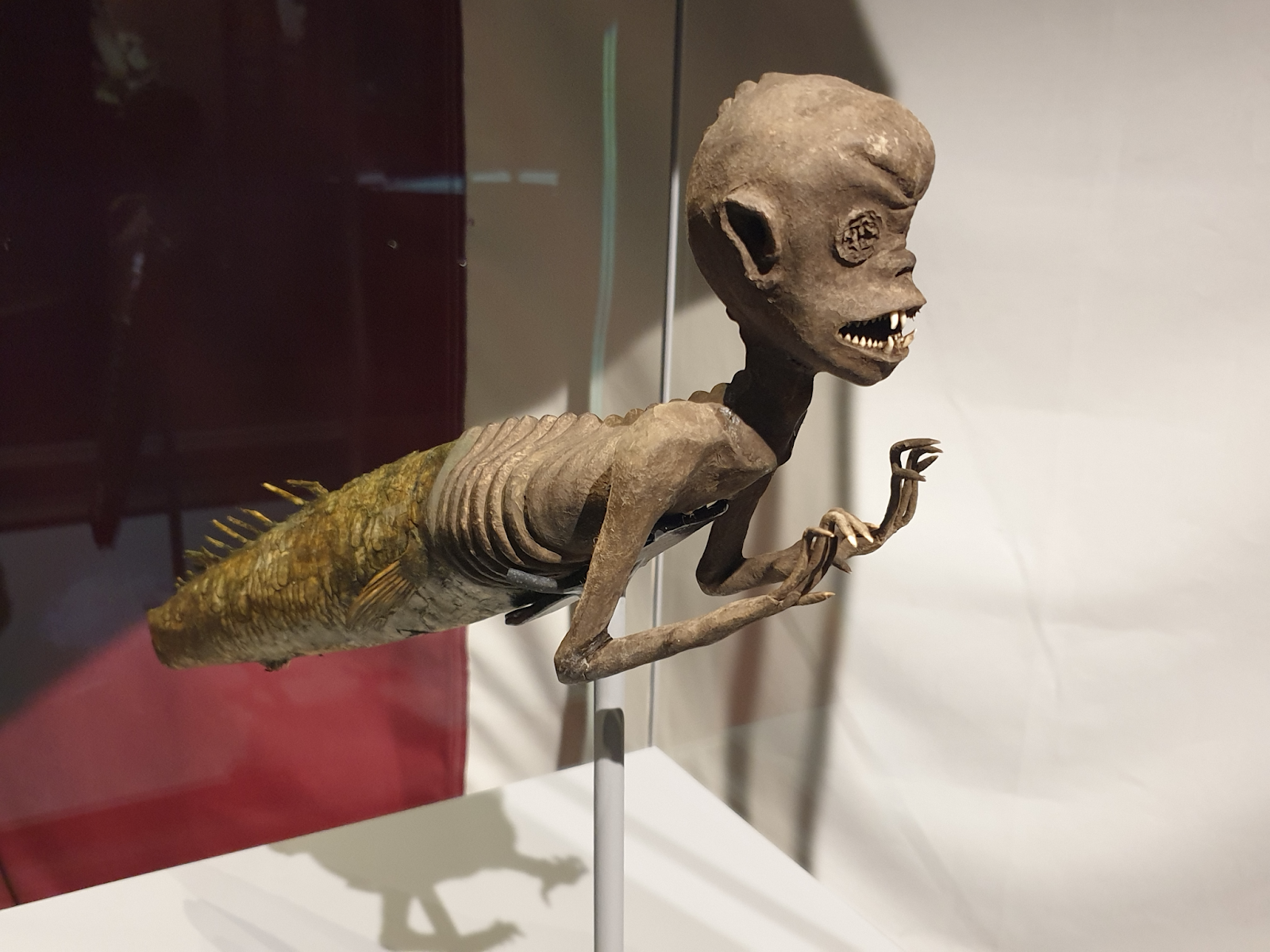
A rare Feejee mermaid on display. Courtesy of National Maritime Museum Cornwall
Another rare creature on display is the Feejee (Fiji) mermaid, a mummified half-mammal, half-fish creature with the head of a small monkey and the tail of a fish believed to be used in sideshows in the 19th century. Legends claim that the mermaid was caught in the South Pacific presenting a frightening departure from the expected traditional image of a beautiful mermaid swimming in the ocean. Recreations of the creature were popular in Japan in the 1800s and sold to sailors as souvenirs. Though commercially reproduced for profit, these specimens are rare as few of them still exist.
“That's an interesting creature. There was this idea that it was a kind of mermaid and whether people believed it or whether they just saw it as a curiosity. They're very rare and we've got one in the exhibition,” said Ball.
Also featured among the displays are some of the modern instruments used in scientific discovery from remotely operated vehicles and satellites to submersibles and sonar technology. While the exhibition appeals to both young and old who are fascinated by sea monsters, its mission is to not just entertain but to educate and make the science relevant to those who see it.
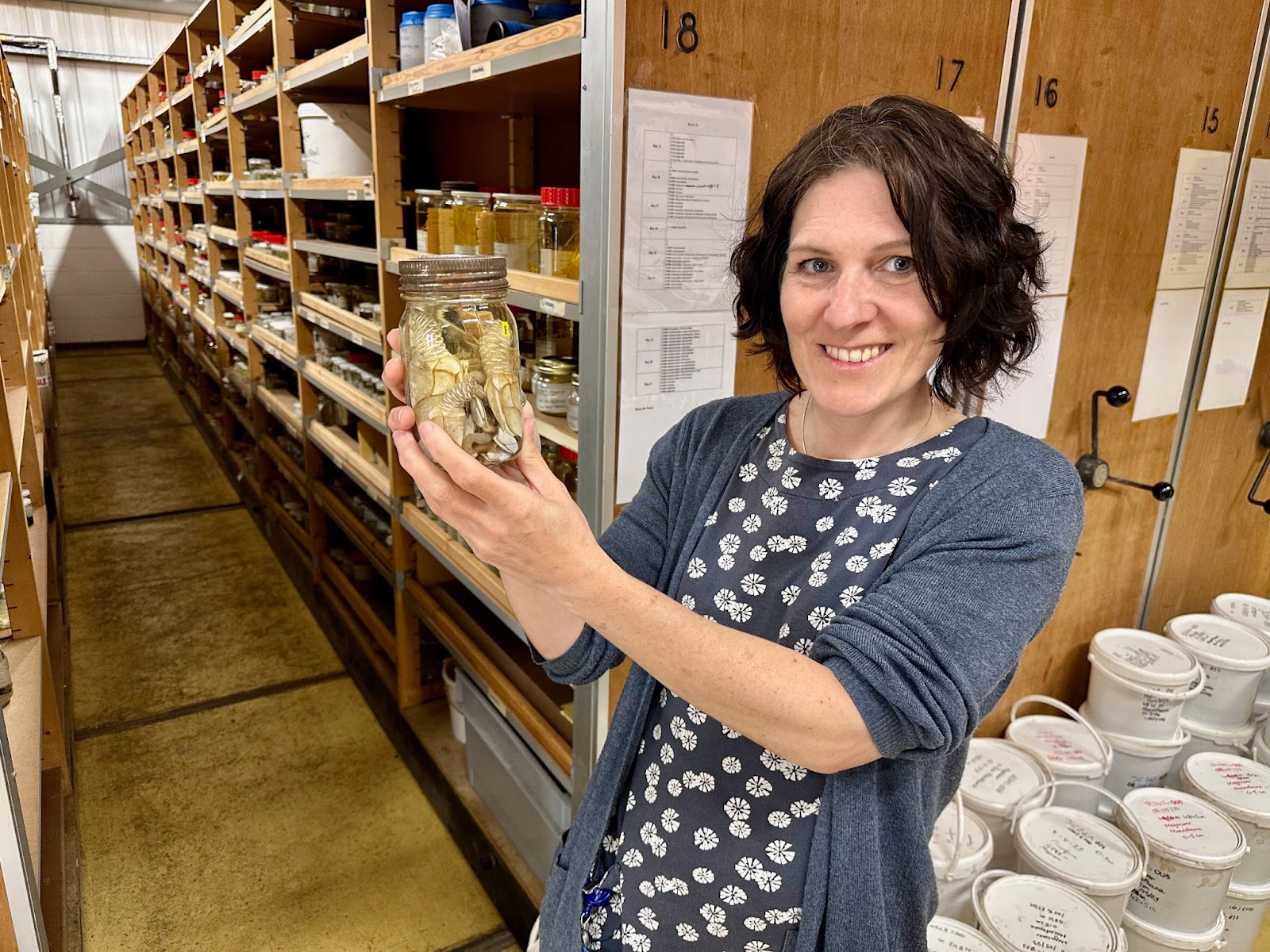
Dr. Tammy Horton takes Kinute behind the scenes of the Discovery Collections Laboratory in England. Photo by Anietra Hamper
Behind the vaults
The centerpiece specimens on display at the Monsters of the Deep exhibition came from the Discovery Collections, the research heart of ocean science located behind the doors of the National Oceanography Centre research facility in England. No one sees these rare finds besides the researchers who study them, but Discovery Collections manager and research scientist Dr. Tammy Horton took Kinute behind the scenes to see where specimens and some of the real sea monsters are collected, identified and studied.
The day of our visit a batch of 5,000 new specimens just arrived off the James Cook research vessel that returned from an 18-day expedition in the Porcupine Abyssal Plain uncovering samples from depths of 13,000 to nearly 16,000 feet.
“I apologize for all the buckets. This is a working collection,” said Dr. Horton, almost giddy at the anticipation of opening the buckets of new arrivals to see what’s been collected on this most recent expedition.
The Discovery Collections has the longest abyssal time series in the world having collected data, samples and specimens from the Porcupine Abyssal Plain since 1989.
“We've got all these samples from the ship and then over the next few months, every single specimen will be analyzed. And by analyzing that will mean taking out every single animal within each bucket that will then be identified as far as you can and put into their own little bracket,” said Dr. Horton.
The stacks of tubs with scribed notes on the lids awaiting the next step in the research process could hold the next big discovery in ocean science.
“It’s fascinating because they're so new and, and you think, no one's ever seen anything like this - I'm the only person on the planet who's seen a thing like this and that's cool,” said Dr. Horton referring to the moments when she sees something new unearthed from expedition samples that will forever change oceanic scientific knowledge.
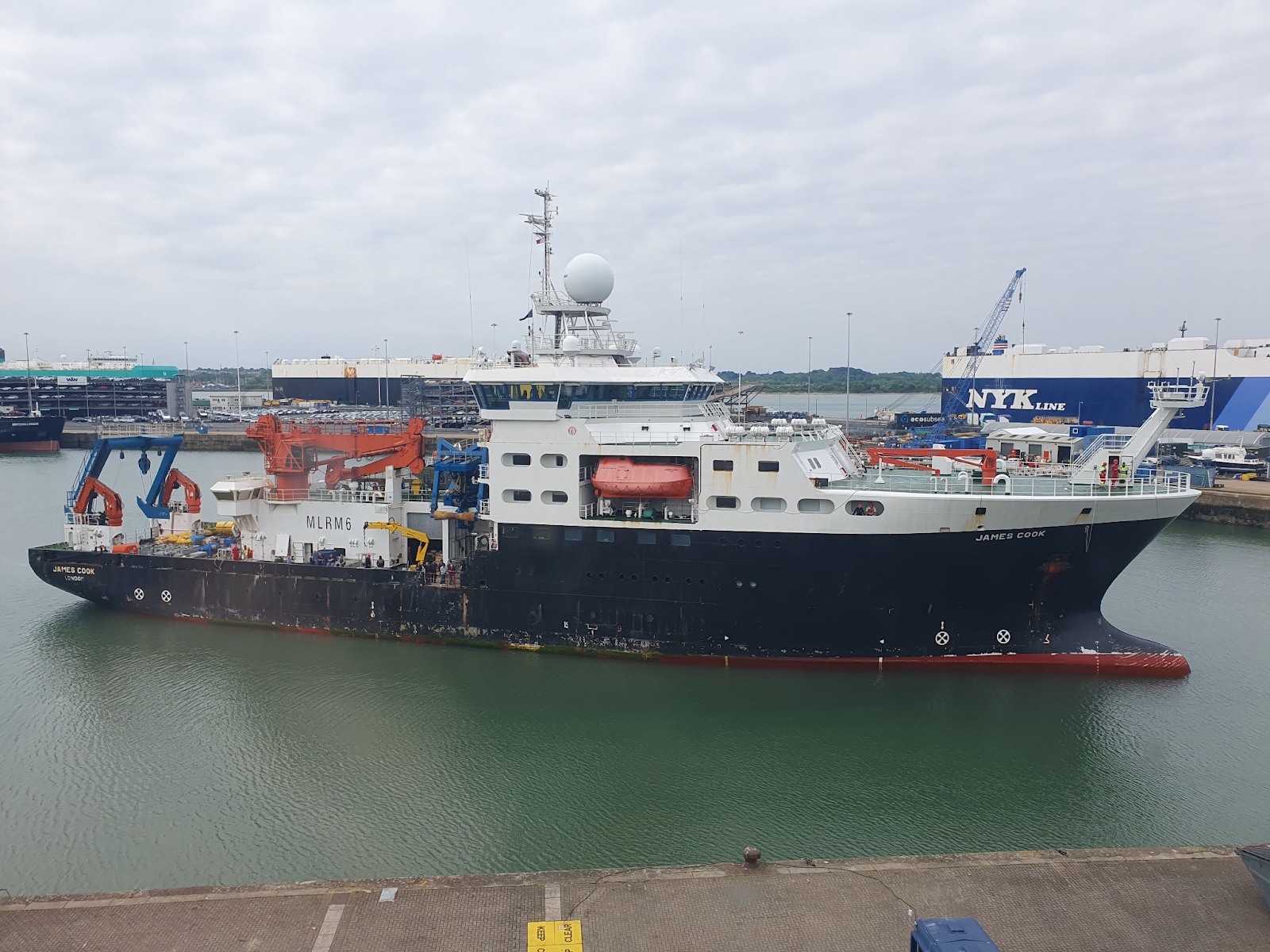
The James Cook research vessel returning from a recent expedition. Photo by Dr. Tammy Horton
The baseline data collected at the Discovery Collections is important to evaluate evolutions in ocean conditions and specimens over time.
“Everyone always underestimates how many different types there are of each thing,” said Dr. Horton. “They'll all be weighed, and then all that data goes into a spreadsheet alongside all the other years’ worth of data. That's what we analyze to see whether there's any changes on a year-to-year basis.”
The research and identification process can take up to 6 months per specimen. The samples range from big animals, arthropods, amphipods, and sea cucumbers to megafauna and sediment. Some of the specimens will be species that are already recognized and others that are new to science that do not even have a name. Then there are the specimens that Dr. Horton refers to as “new old friends,” the ones that scientists have seen before but still do not have names because they’ve never been described.
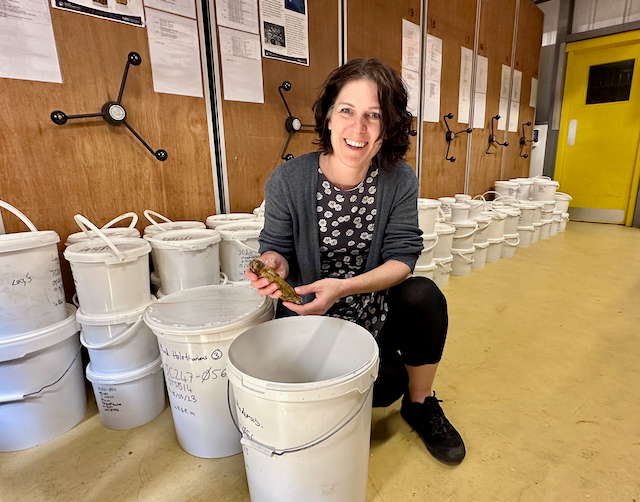
Dr. Tammy Horton pulls out a specimen from a newly arrived research tub at the Discovery Collections lab. Photo by Anietra Hamper
Dr. Horton pulls an “old familiar friend,” from one of the research buckets.
“Ahhh, a sea cucumber,” she remarks with a smile revealing her anticipation of what she will find out about it this time as she begins to analyze the specimen. The sea cucumber is one of the most important specimens for studying in timeline data.
“Our sea cucumbers are important in the deep sea,” said Dr. Horton. “These filter feeders and grazers are the most important animals because they feed on dead carcasses and things that form marine snow, which falls from the ocean and makes the food which the animals in the abyss live on.”
The marine snow comes from events happening on the surface and the year-by-year research is showing a concerning change. Global warming is altering the make-up of the quality and quantity of the marine snow and showing an impact on the specimens collected three miles deep on the ocean floor.
Timeline data and research is at the heart of the mission of the Discovery Collections. The time-series data from the collections go all the way back to 1925 when the first samples were collected by the RRS Discovery in the Southern Ocean. Many of the early 20th-century specimens that are no longer under active research are housed in London’s Museum of Natural History.
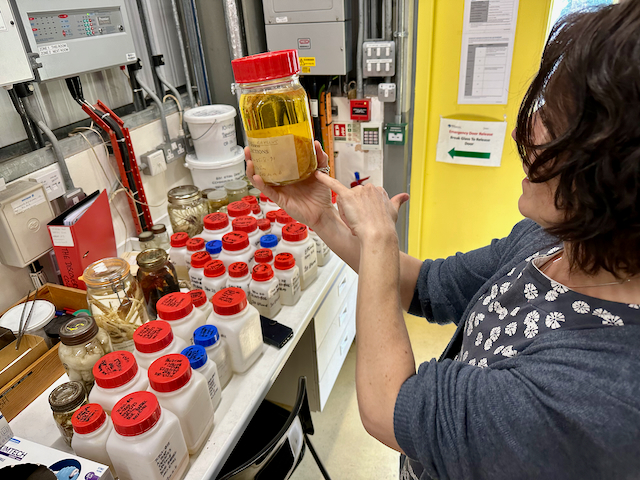
Dr. Tammy Horton holding the oldest specimen in the Discovery Collections that is nearly 100 years old. Photo by Anietra Hamper
The oldest specimen in the collection, a Stalked Barnacle, came from that first expedition and remains an important reminder of the importance of the scientists’ work as it approaches a century of sitting on these laboratory shelves.
The other specimens in the Southampton research lab continue the baseline data collection of the deep-sea with benthic and pelagic samples giving scientists the best look yet at what lives in the ocean’s deepest depths. The goal is to observe, document and understand how species and the environment in which they live in the deep ocean are changing over time.
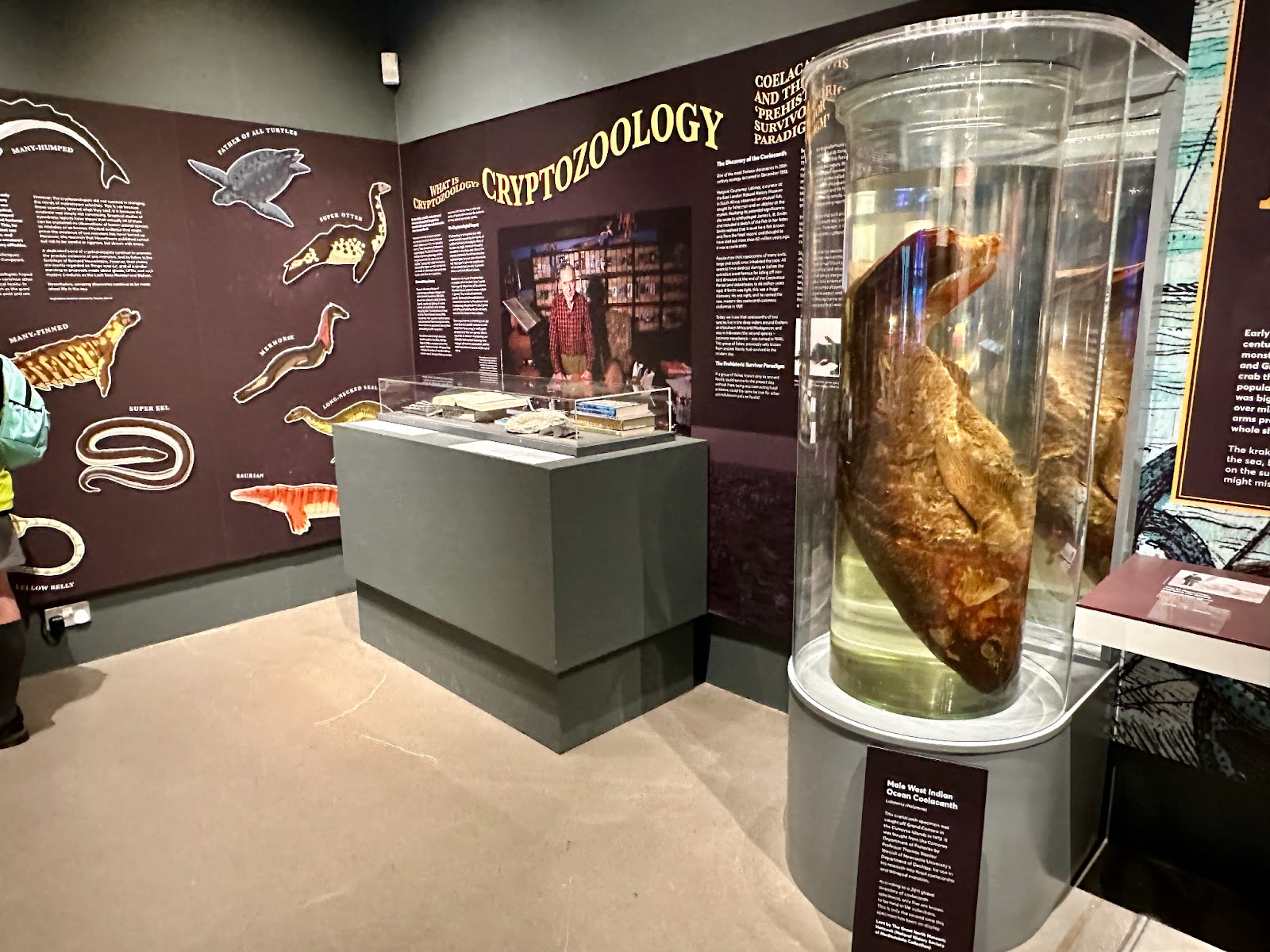
The Coelacanth specimen on display was thought to be extinct millions of years ago. Photo by Anietra Hamper
Finding the deep-sea creatures
Evolving technology and research open the possibilities for learning more about prehistoric deep-sea life, what still exists and what has evolved. Perhaps most intriguing is trying to understand what that could still be out there and is still undiscovered.
One important discovery, the Coelacanth, thought to have gone extinct 65 million years ago, and discovered still alive in 1938, was a game-changer for deep ocean science.
“This [discovery] kind of got people going and thought, wow what else is still out there? Because they thought it was long extinct,” said Ball. “They knew about these fossilized specimens and then they discovered that they were still living and they're quite rare.”
This specimen is on display at the Monsters of the Deep exhibit showcasing the large species that can grow to more than six feet in length, weigh upwards of 200 pounds and live for up to 100 years.
The motivation that came from the discovery of the Coelacanth inspires the promise of continually finding new creatures and possibly some that were not known to exist. The technology available today enables researchers to collect samples deeper than 13,000 feet. Despite the advancement of modern technology like satellites and robots used to collect samples, some old-school methods are still utilized because they are effective.
“We have techniques that are as old as these collections,” said Dr. Horton. “From the 1920s, they were originally collecting samples using nets and trolls. That’s how we still collect our samples today, but we have in addition to newer tools like robots, gliders and autonomous vehicles that can go out and take samples and data on a whole suite of environmental characteristics, which they didn't have back then. We now have the advantages of both.”
Research has evolved to also utilize genetic technology. This enables researchers to remotely collect water sample data, compile it into a barcode and know the kind of DNA that exists in that area of the sea.
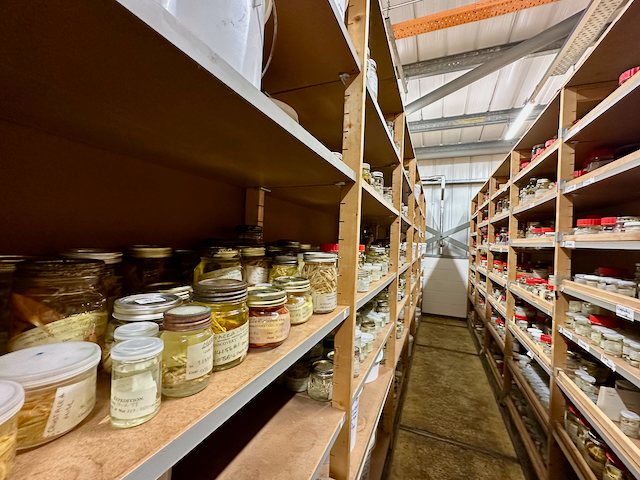
Thousands of deep-sea ocean specimens line the shelves of the Discovery Collections laboratory in the National Oceanography Centre in England. Photo by Anietra Hamper
Why these discoveries matter
Ongoing scientific research and the new discoveries that come with every expedition into the open water are essential to understanding the trajectory of what’s happening to the oceans, the largest environment on the planet.
“The deep sea, the Abyssal Plains make up over half of our planet,” said Dr. Horton. “Half of the planet is deep sea, more than 500 meters. So, although they're out of sight and generally out of mind, they're incredibly important to how our ecosystems function.”
Though science and evolving research provides concrete answers to some things, so much is still unknown about ocean depths leaving room for other possibilities and modern disciplines like Cryptozoology. This middle ground between proven research and mythology suggests that the monsters in legends could exist but are not yet discovered or are neither proven nor disproven.
Sea monsters have been the subject of some of the world’s most fantastical stories, folklore and movie subjects so each new discovery brings to light more clarity to dispel or explain the unknown or in some cases, enhance the mystery of it.
Being able to share these discoveries and highlight the how and why of oceanography research in public forums like the Monsters of the Deep exhibition matters in the bigger picture.
"Human beings are not creatures of the sea, but we have always looked at the sea and wondered what is out there. We have always known that there is ‘weird stuff’ in the sea but early on, we had a belief that whatever was on the land was also in the sea," said Dr. Darren Naish, scientist, zoologist, consultant for the BBC Natural History Unit and co-curator of the Monsters of the Deep exhibition. Sharing this science in a way that the public and non-scientists can understand is one step forward in making everyone part of the solution to help protect these natural environments.
“We are seeing changes in the abyssal community and that's related to changes that we are causing in the operation at the surface. If we change the temperature of the surface sea waters, that changes which animals live there,” said Dr. Horton.
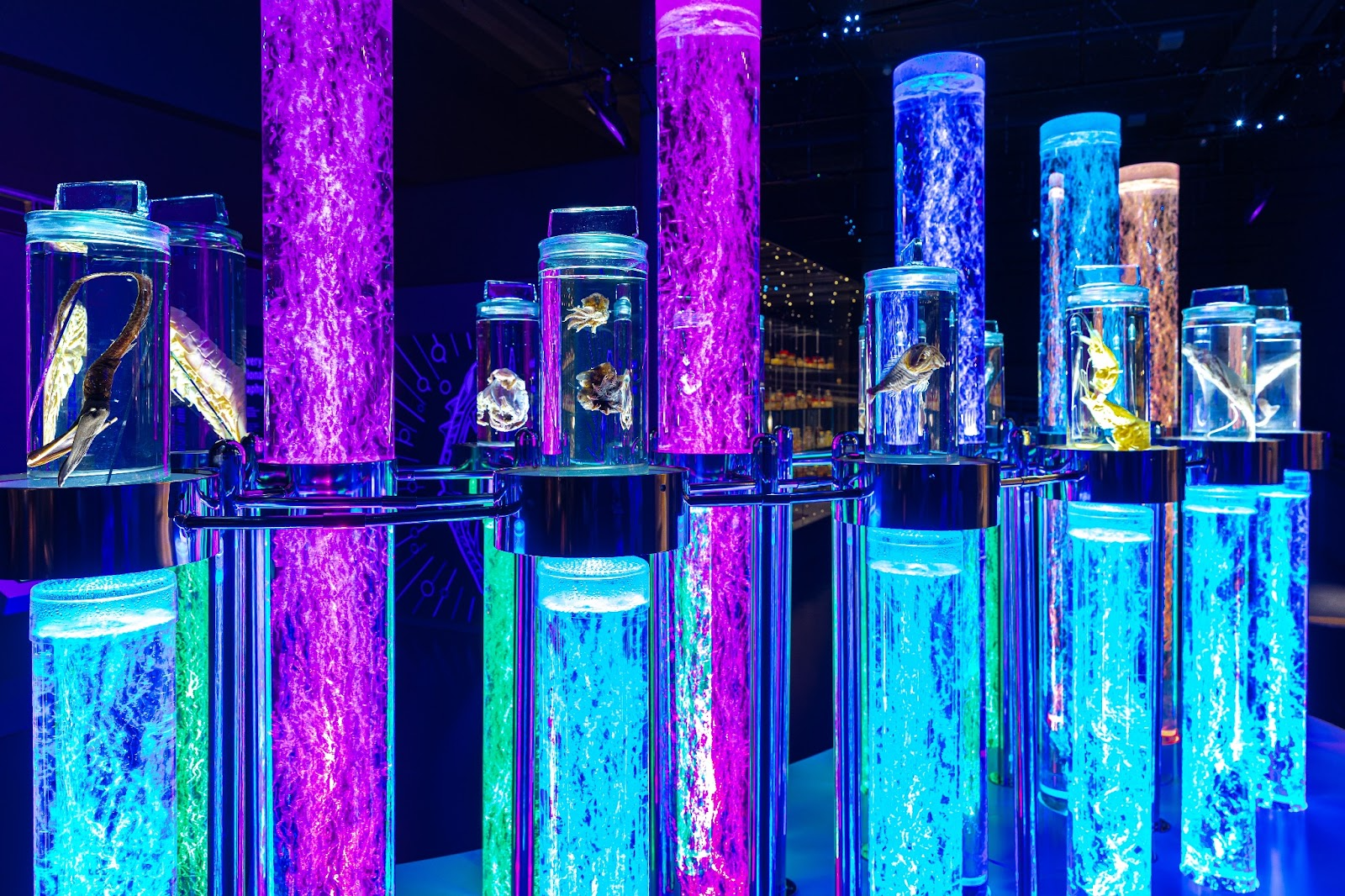
Specimens on display at the Monsters of the Deep exhibition. Photo by Vikki Rimmer
What’s still out there?
So the question remains: what else could be lurking in the world’s greatest depths of the ocean?
“It's not just a question of what's out there, but it's also interesting to think and discover what people used to think was out there compared to what we know. At least we know some of it exists, but there's still a great mystery around the deep sea and I think that's partly what fascinates people,” said Ball.
For as long as that fascination exists there is an opportunity to make the deep sea relevant to people and help them understand their role in its future. Dr. Horton’s work is an important part of that, but understanding where environmental changes go from here is as unknown as many of the creatures in the deep ocean.
“It is difficult to think of a trajectory of what could happen because we're only just mapping it, but I expect like everywhere there are going to be changes in our deep sea, even impacting our deep-sea ecosystems,” said Dr. Horton. “We must be able to explain to governments and policymakers and the public to understand how much diversity is in our oceans, why that's important and why it's important that we continue to study it. We must be able to communicate how this is changing, what impacts we are having on it.”
